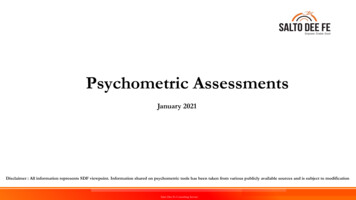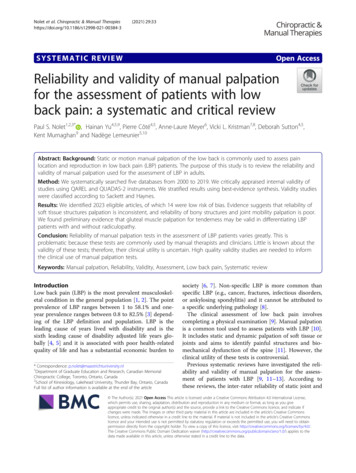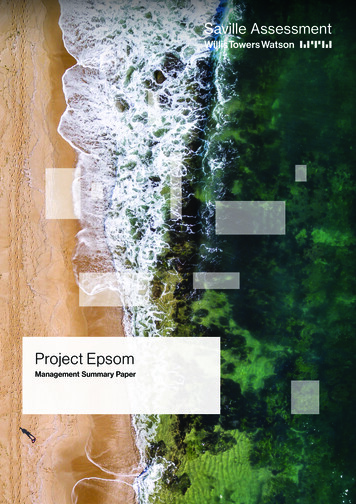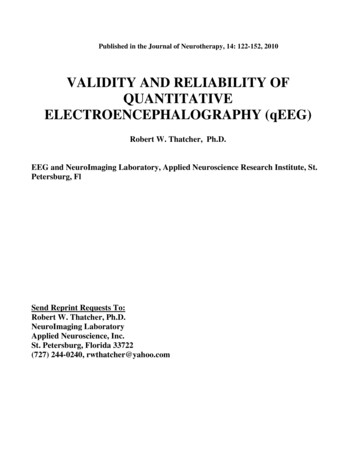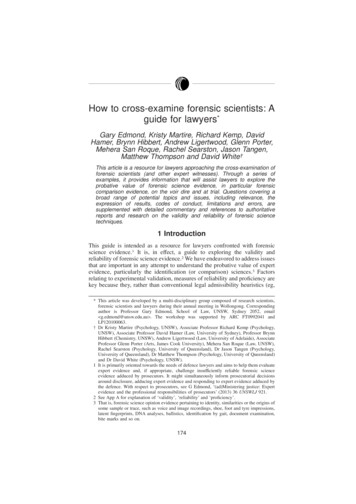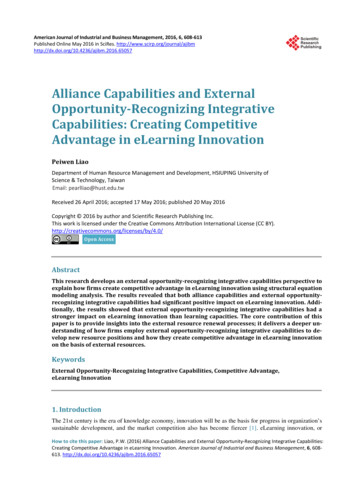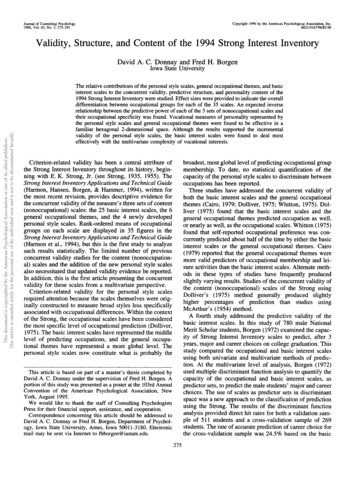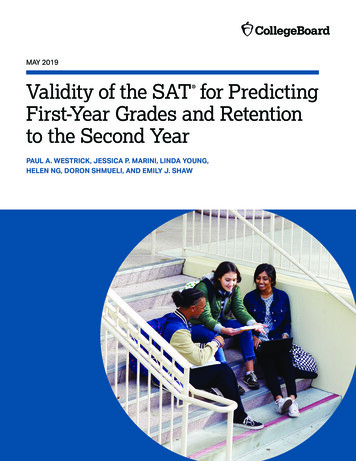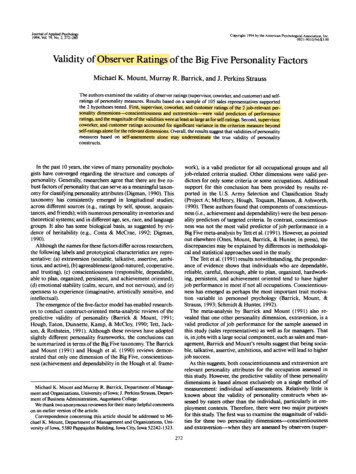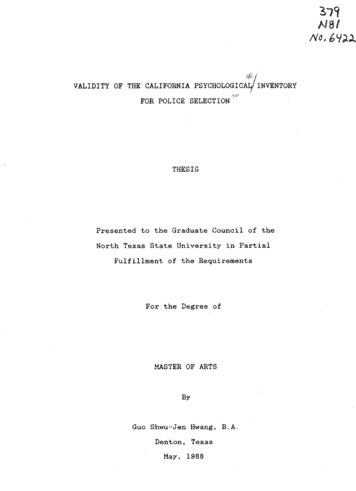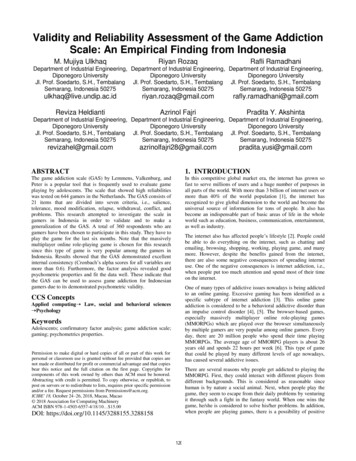
Transcription
Validity and Reliability Assessment of the Game AddictionScale: An Empirical Finding from IndonesiaM. Mujiya UlkhaqRiyan RozaqRafli RamadhaniDepartment of Industrial Engineering, Department of Industrial Engineering, Department of Industrial Engineering,Diponegoro UniversityDiponegoro UniversityDiponegoro UniversityJl. Prof. Soedarto, S.H., Tembalang Jl. Prof. Soedarto, S.H., Tembalang Jl. Prof. Soedarto, S.H., TembalangSemarang, Indonesia 50275Semarang, Indonesia 50275Semarang, Indonesia afly.ramadhani@gmail.comReviza HeldiantiAzrinol FajriPradita Y. AkshintaDepartment of Industrial Engineering, Department of Industrial Engineering, Department of Industrial Engineering,Diponegoro UniversityDiponegoro UniversityDiponegoro UniversityJl. Prof. Soedarto, S.H., Tembalang Jl. Prof. Soedarto, S.H., Tembalang Jl. Prof. Soedarto, S.H., TembalangSemarang, Indonesia 50275Semarang, Indonesia 50275Semarang, Indonesia adita.yusi@gmail.comABSTRACT1. INTRODUCTIONThe game addiction scale (GAS) by Lemmens, Valkenburg, andPeter is a popular tool that is frequently used to evaluate gameplaying by adolescents. The scale that showed high reliabilitieswas tested on 644 gamers in the Netherlands. The GAS consists of21 items that are divided into seven criteria, i.e., salience,tolerance, mood modification, relapse, withdrawal, conflict, andproblems. This research attempted to investigate the scale ingamers in Indonesia in order to validate and to make ageneralization of the GAS. A total of 360 respondents who aregamers have been chosen to participate in this study. They have toplay the game for the last six months. Note that the massivelymultiplayer online role-playing game is chosen for this researchsince this type of game is very popular among the gamers inIndonesia. Results showed that the GAS demonstrated excellentinternal consistency (Cronbach’s alpha scores for all variables aremore than 0.6). Furthermore, the factor analysis revealed goodpsychometric properties and fit the data well. These indicate thatthe GAS can be used to assess game addiction for Indonesiangamers due to its demonstrated psychometric validity.In this competitive global market era, the internet has grown sofast to serve millions of users and a huge number of purposes inall parts of the world. With more than 3 billion of internet users ormore than 40% of the world population [1], the internet hasrecognized to give global dimension to the world and become theuniversal source of information for tons of people. It also hasbecome an indispensable part of basic areas of life in the wholeworld such as education, business, communication, entertainment,as well as industry.The internet also has affected people’s lifestyle [2]. People couldbe able to do everything on the internet, such as chatting andemailing, browsing, shopping, working, playing game, and manymore. However, despite the benefits gained from the internet,there are also some negative consequences of spreading internetuse. One of the negative consequences is internet addiction, i.e.,when people put too much attention and spend most of their timeon the internet.One of many types of addictive issues nowadays is being addictedto an online gaming. Excessive gaming has been identified as aspecific subtype of internet addiction [3]. This online gameaddiction is considered to be a behavioral addictive disorder thanan impulse control disorder [4], [5]. The browser-based games,especially massively multiplayer online role-playing games(MMORPGs) which are played over the browser simultaneouslyby multiple gamers are very popular among online gamers. Everyday, there are 20 million people who spend their time playingMMORPGs. The average age of MMORPG players is about 26years old and spends 22 hours per week [6]. This type of gamethat could be played by many different levels of age nowadays,has caused several addictive issues.CCS ConceptsApplied computing Law, social and behavioral sciences PsychologyKeywordsAdolescents; confirmatory factor analysis; game addiction scale;gaming; psychometrics properties.Permission to make digital or hard copies of all or part of this work forpersonal or classroom use is granted without fee provided that copies arenot made or distributed for profit or commercial advantage and that copiesbear this notice and the full citation on the first page. Copyrights forcomponents of this work owned by others than ACM must be honored.Abstracting with credit is permitted. To copy otherwise, or republish, topost on servers or to redistribute to lists, requires prior specific permissionand/or a fee. Request permissions from Permissions@acm.org.ICIBE' 18, October 24–26, 2018, Macau, Macao 2018 Association for Computing MachineryACM ISBN 978-1-4503-6557-4/18/10 15.00There are several reasons why people get addicted to playing theMMORPG. First, they could interact with different players fromdifferent backgrounds. This is considered as reasonable sincehuman is by nature a social animal. Next, when people play thegame, they seem to escape from their daily problems by venturingit through such a fight in the fantasy world. When one wins thegame, he/she is considered to solve his/her problems. In addition,when people are playing games, there is a possibility of positiveDOI: https://doi.org/10.1145/3288155.3288158120
subjective experience that person reports as a result ofengagement in games. It may also include tranquilizing and/orrelaxing feelings related to escapism. Fourth criterion iswithdrawal. It is unpleasant emotions and/or physical effects thatoccur when game play is suddenly reduced or discontinued. Itconsists of moodiness, irritability, as well as shaking asphysiological symptom. The next criterion is relapse. It is atendency to repeatedly revert to earlier patterns of game play.Sixth criterion is conflict. It refers to all interpersonal conflictsresulting from excessive gaming. It may include arguments,neglects, lies, as well as deceptions. The last criterion is problems.This refers to problems caused by excessive game play. It mainlyconcerns displacement problems as the object of addiction takespreference over activities, such as school, work, and socializing. Itmay arise within the individual, such as intrapsychic conflict andsubjective feelings of loss of control.events (wins) as well as negative events (loses). It is considered asan addictive potential for inducing player conditions throughvariable-ratio reinforcement schedules, or it is called an effectiveconditioning [7].Game addiction is currently one of the most discussed psychosocial aspects. Being addicted to the game is an excessive andcompulsive behavior and it could affect the social life or evenemotion of the players and obviously, the players cannot controlthe excessive use of the game [8]. Recently, some researchershave studied and briefly concluded that the addiction number isgrowing with the aid of the internet, such as in Italy [9], Pakistan[10], and Czech Republic [11]. More serious condition happenedin China, where more than 30 million of internet gamers were saidto be addicted. To eradicate this epidemic condition, the Chineseauthorities had to take an action to shut down some internet cafesregularly and set up laws to limit the number of hours foradolescents to play the online games [5].The participants are given an online questionnaire that comprisesthose all criteria. Every item was preceded by the statement:―How often during the last six months ?‖ All items were scoredon a 5-point Likert scale ranging from 1 (never), 2 (rarely), 3(sometimes), 4 (often), and 5 (very often). This 5-point ratingscale offers sufficient distribution of responses [19]. Note that weused the Indonesian translation rather than the original GAS tomake the respondents easier to understand.In order to measure game addiction, some studies have beenconducted to accomplish this issue. Among those, the gameaddiction scale (GAS) by [8] is considered as a popularmeasurement to assess game addiction. In addition, it is the onlyinstrument that covered the highest number of factors mentionedin the literature concerning game addiction [12]. The scalecomprises seven criteria in which each criterion has three itemquestions. The original GAS was first used in May 2007 and wasapplied to 644 adolescents from six secondary schools in theNetherlands. The scale showed high internal consistency andreliability; thus, it has been translated and adopted in measuringgame addiction in Norway [13], French [14], China [15], Brazil[16], and Turkey [17].Descriptive statistics were used to access sociodemographiccharacteristics and the data are presented as a number andpercentage or a mean and standard deviation. This data analysiswas performed using the Statistical Package for the SocialSciences (SPSS 16.0, SPSS Inc., Chicago). A confirmatory factoranalysis (CFA) was performed to assess the construct validity.The SPSS Analysis of Moment Structures (SPSS AMOS v20,AMOS Development Corporation) was employed to accomplishthis task. This CFA was computed using the maximum likelihoodestimator. We calculated the chi-square value ( 2), which shouldbe low or nonsignificant in order to consider the fit as acceptable[20]. The following fit indexes were used to evaluate the model’sgoodness of fit. The Comparative Fit Index (CFI) and the TuckerLewis Index (TLI) indicate a very good fit if they are close to 1,and an acceptable fit if they are greater than 0.90. The Root MeanSquare Error of Approximation (RMSEA) with a 90% confidenceinterval (90% CI) indicates an acceptable fit if less than 0.08 and agood fit if less than 0.05 [20], [21]. Cronbach’s alpha [22] wasused to measure internal consistency as an indicator of scalereliability; it should be greater than 0.60 [23].We sought to investigate the psychometric properties of the GASin Indonesia because new instruments are needed to successfullyand accurately assess game addiction in this population.Validating a tool that serves this purpose will assist mental healthprofessionals in evaluating game addiction. This study assessedthe construct and convergent validity as well as reliability of theGAS according to measures of internal consistency.2. MATERIALS AND METHODS2.1 ParticipantsThe study sample included 360 gamers who were between 5 and40 years of age from Indonesia. The inclusion criteria were acurrent game user of MMORPGs over the last six months—addiction is present when a person meets the specific criteriaduring a period of six months [18]. We chose MMORPG sincethis type of games is very popular among gamers in Indonesia.The participants of this research were first approached and askedif they agree to participate in the survey. The participants thenprovided their demographic information, such as age, sex,occupation, residence; their informed consent, such as frequencyand type of game played. Note that there is no compensation wasgiven for their participation.3. RESULTS AND DISCUSSIONA total of 474 respondents participated in this survey. However,only 360 respondents who completed in submitting thequestionnaire. Profile of the 360 respondents is given in Table 1.Note that male respondents dominate female respondents with71.11% over 28.89%. More than 90% of the participants were inthe range of 17 to 25 years old, indicated that most of the onlinegame players are teenagers. Mobile legend is the most popularMMORPG among others with more than half of the respondentsfrequently play this game.2.2 Instruments and ProcedureThis research used the GAS by [8] that consists of 21 items thatare divided into seven criteria. Each criterion comprises of threeitems. The first criterion is salience. A game addicted person feelsthat playing a game is the most important activity in his/her lifeand dominates his/her thinking, feelings, and behavior. The nextcriterion is tolerance. It means that while person starts playinggames more often, it is gradually building up the amount of timespent of games. The next criterion is mood modification. It isThe reliability in terms of internal consistency was good (seeTable 2 for the Cronbach’s alpha scores of each criterion). TheCFA model of the Indonesian version of the GAS is shown inFigure 1. The model revealed a factor loading for every item thatwas greater than 0.50 (see Table 3). Furthermore, the CFA modelshowed a 2 (163) 311.394; p-value 0.000 (CFI 0.952; TLI 0.940; RMSEA 0.049). The ovals in Figure 1 indicate latent121
consequences is a vital element in distinguishing addiction fromhabits (e.g., [29]). By their definition, the criteria conflict,withdrawal, and problems as well indicate negative lifeconsequences and pathological tendencies [30]. Because themonothetic format requires all criteria have to be met, this formatautomatically incorporates the endorsement of the criteria fornegative life consequences, thus, allowing a more accuratedistinction between habitual behavior and addiction.constructs, i.e., the criteria, and the rectangles represent theobserved items, i.e., the 21-item questions. The results indicatedthat the model of the 21-item GAS had good psychometricproperties and fit the data well. These results are similar to thoseobtained by [8] in their original study.Table 1. Profile of the male28.895 – 174.7317 – 2594.72Age:26 – 350.28 350.27Mobile legend54.17Arena of valor1.39Dota 27.22Type of game Counter strike6.67played*: Point nt95.56Employment Employee2.5status: Freelance1.11Others0.83Every day53.33Every three days23.89Frequency of Once a week10.28game played: Twice a week2.78Once a month3.33Less than once a month6.39Note: *the participants could choose more than one.Figure 1. The Confirmatory Factor Analysis of the GameAddiction ScaleOne of the interesting questions could be how to determinewhether someone is addicted to games or not. Based on argumentsby [24] and also adapted by [8], there are two formats todetermine that condition, i.e., monothetic format and polytheticformat. In the first format, all item questions must be endorsed inorder to be identified as a game addict. On the other hand, in thesecond format, one could be classified as a game addict if at leasthalf of the total item questions are endorsed.Table 2. Cronbach’s Alpha for Each Criterion of GameAddiction ScaleIn this research, we used two types of cut-off point as itemquestion is labeled as endorsed: a) when a person answered 3(sometimes), 4 (often), or 5 (very often) and b) when oneanswered 4 or 5 on the 21 item questions. The polythetic formatresulted in 61.94% of the gamers were classified as problematicgamers using the first cut-off point and 19.44% using the secondcut-off point. With a monothetic format (validation of all items)only 4.17% and none of the respondents were classified as gameaddicts using the first and second cut-off point respectively, whichcould be an under-estimation [25]. This might raise a question ofwhich format is best to be applied.CriteriaCronbach’s AlphaSalience0.681Tolerance0.740Mood ct0.741Problems0.738Whichever format is applied, these self-reported outcomes shouldcurrently only be used to provide an indication of the prevalenceof game addiction. Before it is used as a diagnostic tool, clinicalpsychologists should decide whether game addiction can beconsidered a legitimate pathology. For the majority of gameplayers, their game addiction scores merely reflect enthusiasm forgames or a relatively harmless displacement from other activities.However, for a small minority of gamers, their scores indicatedmore serious problems arising from compulsive use. It is animportant issue that should be addressed.There are two arguments why the monothetic approach wouldlead to a better estimate of addicted gamers. First, the polytheticformat is likely to lead to over-estimation of the frequency ofaddicted gamers; see for example 9.4% in [8], 39% in [24], 16%in [26], and 20% in [27]. On the other hand, when [24] applied amonothetic format, they found that 1.8% of their respondentscould be labeled as addicted, which is proportionate to theestimated percentage of pathological gamblers [28]. Second, someresearchers stated that the occurrence of negative life122
three item questions as indicators, so that the scale covers a totalof 21 item questions to measure game addiction.4. CONCLUSIONThis study aimed to evaluate the psychometric properties of theIndonesian version of the GAS. The scale comprises seven criteria,namely, salience, mood modification, tolerance, withdrawal,relapse, conflict, and problems. On each of those criteria, there areThe scale used in this research was considered reliable, had goodinternal consistency, as well as good temporal stability. The CFAmodel that was generated also indicated that the 21-item scale isTable 3. Measurement Loadings of the Game Addiction ScaleHow often during the last six months 0X21SalienceDid you think about playing a game all day long?Did you spend much free time on games?Have you felt addicted to a game?ToleranceDid you play longer than intended?Did you spend increasing amounts of time on games?Were you unable to stop once you started playing?Mood ModificationDid you play games to forget about real life?Have you played games to release stress?Have you played games to feel better?RelapseWere you unable to reduce your game time?Have others unsuccessfully tried to reduce your game use?Have you failed when trying to reduce game time?WithdrawalHave you felt bad when you were unable to play?Have you become angry when unable to play?Have you become stressed when unable to play?ConflictDid you have fights with others (e.g., family, friends) over your time spent on games?Have you neglected others (e.g., family, friends) because you were playing games?Have you lied about time spent on games?ProblemsHas your time on games caused sleep deprivation?Have you neglected other important activities (e.g., school, work, sports) to play games?Did you feel bad after playing for a long .740.740.612.902.503.101.301.201.30[3] Block, J. J. 2008. Issues for DSM-V: internet addiction. Am.J. Psychiat. 165, 306–307.appropriate for the population assessed here. It seems that thecultural differences or differences in age have no effect in thisresearch (note the original version of GAS was assessed on Dutchadolescence gamers). It is quite interesting since the GAS scalehas faced different result when it adopted in other populations, seefor example: [14] who adapted the GAS in France; [16] in Brazil;and [17] in Turkey. It concludes that the Indonesian version of the21-item scale of GAS exhibits acceptable psychometric propertiesthat confirm its theoretical and concurrent validity. It seems thatthe scale is considered as reliable assessment tool for identifyingand capturing the problematic use of games and should be usefulin future research.[4] Pezoa-Jares, R. E, Espinoza-Luna, I. L., and VasquezMedina, J. A. 2012. Internet addiction: a review. J. Addict.Res. Ther. 6, 004.[5] Kuss, D. J. and Griffiths, M. D. 2012. Online gamingaddiction in children and adolescents: a review of empiricalresearch. J. Behav. Addict. 1, 3-22.[6] Yee, N. 2006. Motivations for play in online games.Cyberpsychol. Behav. 9, 772-775.5. REFERENCES[7] Wallace, P. M. 1999. The Psychology of the Internet.Cambridge University Press, New York.[1] Internet Live Stats 2018. Internet Users. available / (accessed: 5June 2018).[8] Lemmens, J. S., Valkenburg, P. M., and Peter J. 2009.Development and validation of a game addiction scale foradolescents. Media Psychol. 12, 77-95.[2] Young, K. 2009. Understanding online gaming addiction andtreatment issues for adolescent. Am. J. Family Therapy 37,355-372.[9] Ferraro, G., Caci, B., D’Amico, A., and Di Biasi, M. 2007.Internet addiction disorder: an Italian study. Cyberpsychol.Behav. 10, 170-175.123
[20] Brown, T. A. 2006. Confirmatory Factor Analysis forApplied Research. The Guilford Press, New York.[10] Suhail, K. and Bargees, Z. 2006. Effects of excessive internetuse on undergraduate students in Pakistan. Cyberpsychol.Behav. 9, 297-307.[21] Schermelleh-Engel, K. M. 2003. Evaluating the fit ofstructural equation models: tests of significance anddescriptive goodness-of-fit measures. Methods Psychol. Res.8, 23–74.[11] Simkova, B. and Cincera, J. 2004. Internet addiction disorderand chatting in the Czech Republic. Cyberpsychol. Behav. 7,536-539.[22] Cronbach, L. J. 1951. Coefficient alpha and the internalstructure of tests. Psychometrika 16, pp. 297–334.[12] King, D. L., Haagsma, M. C., Delfabbro, P. H., Gradisar, M.,and Griffiths, M. D. 2014. Toward a consensus definition ofpathological video-gaming: a systematic review ofpsychometric assessment tools. Clin. Psychol. Rev. 33, 33142.[23] Nagpal, J., Kumar, A., Kakar, S., and Bhartia, A. 2010. Thedevelopment of Quality of Life Instrument for IndianDiabetes patients (QOLID): a validation and reliability studyin middle and higher income groups. J. Assoc. PhysiciansIndia 58, 295–304.[13] Mentzoni, R. A., Brunborg, G. S., Molde, H., Myrseth, H.,Skouverøe, K. J., Hetland, J., and Pallesen, S. 2011.Problematic video game use: estimated prevalence andassociations with mental and physical health. Cyberpsychol.Behav. Soc. Netw. 14, 591-596.[24] Charlton, J. P. and Danforth, I. D. W. 2007. Distinguishingaddiction and high engagement in the context of online gameplaying. Comput. Hum. Behav. 23, 1531-1548.[14] Gaetan, S., Bonnet, A., Brejard, V., and Cury, F. 2014.French validation of the 7-item game addiction scale foradolescents. Revue EPsychologie A64,161–168.[25] Van Rooij, A. J., Schoenmakers, T. M., Vermulst, A., Vanden Eijnden, R., and Van de Mheen, D. 2010. Online videogame addiction: identification of addicted adolescentsgamers. Addiction 106, 205–212.[15] Wang, C. W., Chan, C. L. W., Mak, K. K., Ho, S. Y., Wong,P. W. C., and Ho, R. T. H. 2014. Prevalence and correlates ofvideo and internet gaming addiction among Hong Kongadolescents: a pilot study. Sci. World J. 2014.[26] Griffiths, M. D. 1997. Computer game playing in earlyadolescence. Youth Soc. 29, 223–238.[27] Griffiths, M. D. and Hunt, N. 1998. Dependence oncomputer games by adolescents. Psychol. Rep. 82, 475–480.[16] Lemos, I. L., Cardoso, A., and Sougey, E. B. 2016. Validityand reliability assessment of the Brazilian version of thegame addiction scale (GAS). Compr. Psychiat. 67, 19-25.[28] Walker, M. B. and Dickerson., M. G. 1996. The prevalenceof problem and pathological gambling: A critical analysis. J.Gambl. Stud. 12, 233–249.[17] Baysak, E., Kaya, F. D., Dalgar, I., and Candansayar, S. 2016.Online game addiction in a sample from Turkey:development and validation of the Turkish version of gameaddiction scale. Klinik Psikofarmakoloji Bulteni 26, 21–31.[29] LaRose, R., Lin, C. A., and Eastin, M. S. 2003. Unregulatedinternet usage: addiction, habit, or deficient self-regulation.Media Psychol. 5, 225–253.[30] Seay, A. F. and Kraut, R. E. 2007. Project massive: selfregulation and problematic use of online gaming. InProceedings of the ACM Conference on Human Factors inComputing Systems (San Jose, CA, April 30 – May 03, 2007).CHI’07.ACM,NewYork,NY,829–838.[18] Young, K. S. 1998. Caught in the Net: How to RecognizeInternet Addiction and a Winning Strategy for Recovery.John Wiley & Sons, Inc., New York.[19] Comrey, A. L. 1988. Factor-analytic methods of scaledevelopment in personality and clinical psychology. J.Consul. Clin. Psych. 56, 754-761.124
A total of 474 respondents participated in this survey. However, only 360 respondents who completed in submitting the questionnaire. Profile of the 360 respondents is given in Table 1. Note that male respondents dominate female respondents with 71.11% over 28.89%. More than 90% of the participants were in
